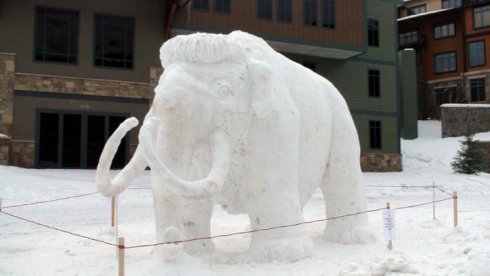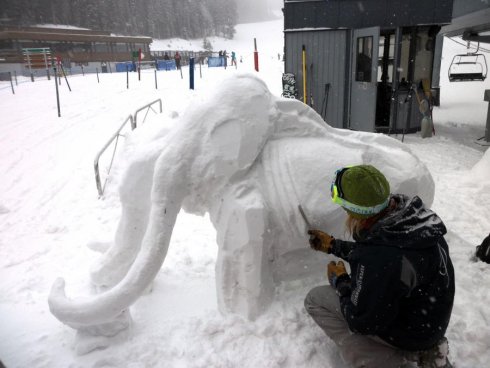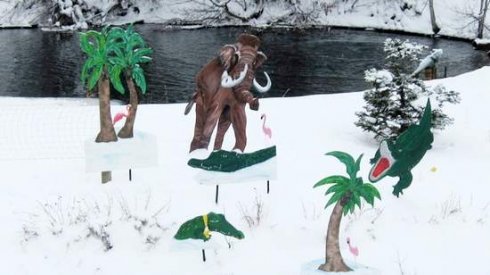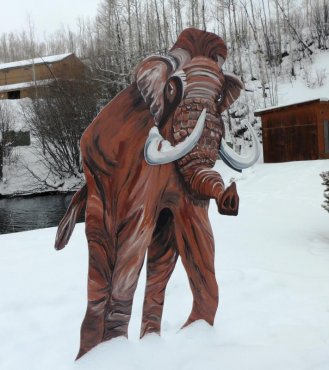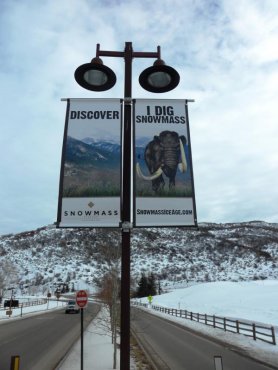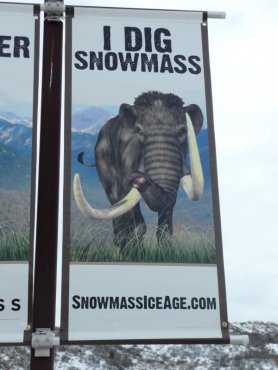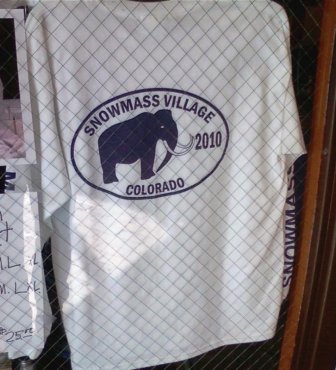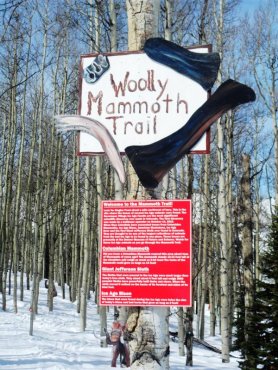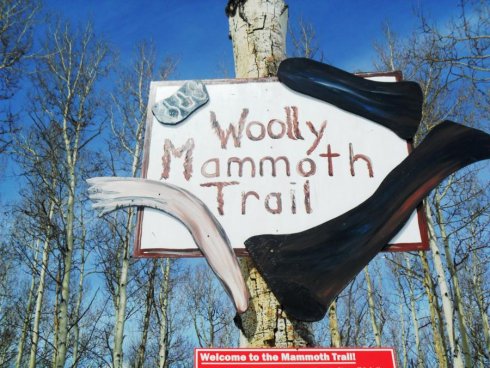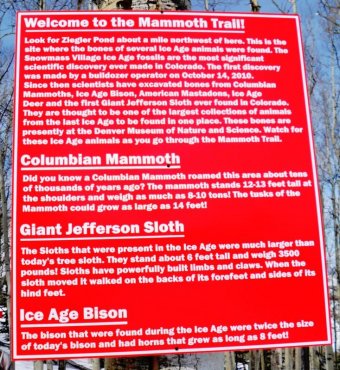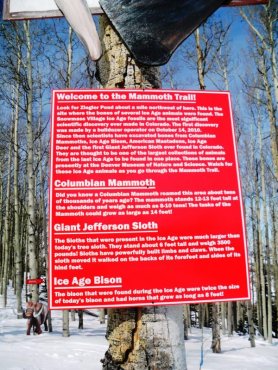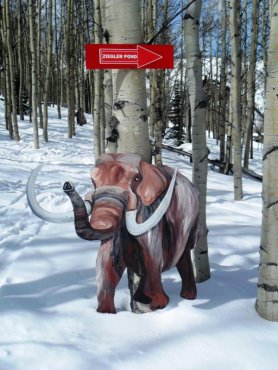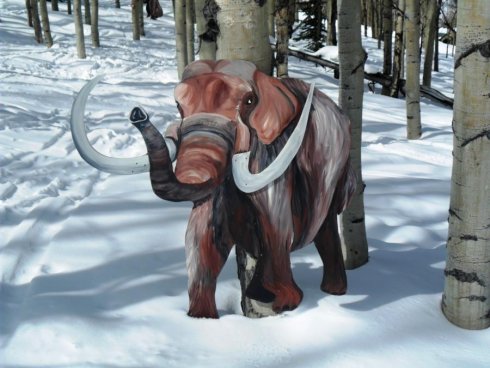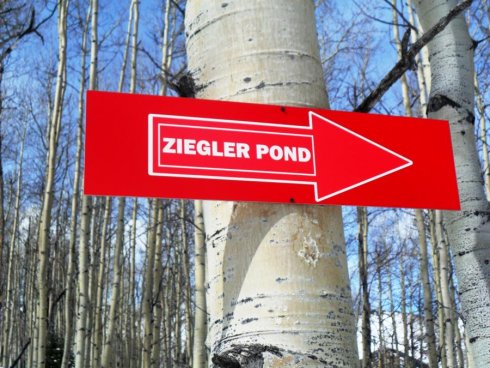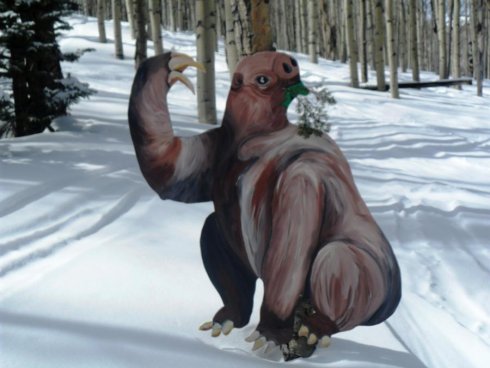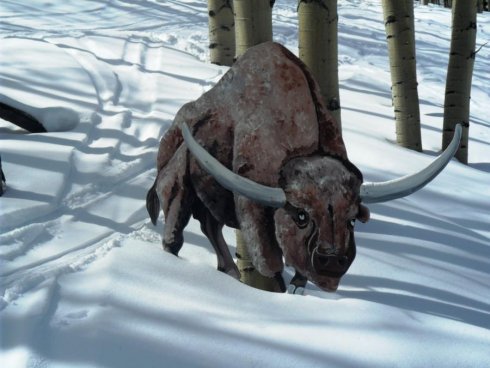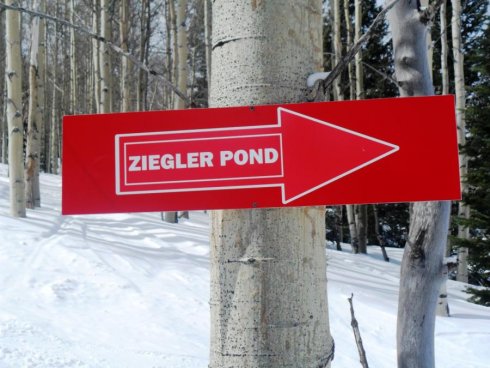The Woolly Mammoth Trail (Snowmass)
- May 25, 2011: Excavation Of Ice-Age Fossils, Race Against Time - Denver News Story - KMGH Denver
- May 24, 2011: More Than 100 More Bones Found At Colo. Fossil Dig
- May 18, 2011: Ice Age Camel Found At Colorado Fossil Site
- May 16, 2011: Museum Releases Packing List For Fossil Dig
- January 18, 2011: Mammoth Uncovered Near Snowmass Village Named
- December 18, 2010: Help Name First Mammoth Discovered In Snowmass
- November 18, 2010: Bones From Aspen Excavation On Display In Denver Saturday
- November 16, 2010: Snowmass Dig Turns Up 500+ Bones
- November 9, 2010: Snowmass Prehistoric 'Zoo' Now Up To 7 Species
- November 7, 2010: Huge Ice Age Bison Skull Unearthed At Snowmass
- November 5, 2010: Bones Of 5 Species Uncovered At Colorado Site
- November 3, 2010: Large Skull Uncovered Where Mammoth Bones Found
- October 26, 2010: Snowmass Turns Mammoth Discovery Over To Museum
- October 22, 2010: Mammoth Bones May Not Be So Woolly
Click on images to enlarge.
When the "Woolly Mammoth Trail" first appeared on Snowmass, it was located near Lizard Lodge. Between April 2011 and November 2011, it was moved to a lower location, near the Dawdler Shack. The sign there says "Wooly Mammoth Trail" but it is shown on the kids trail map as "Mammoth Traverse." Below are photos of it. Click on images to enlarge.
Ice Age bones in Snowmass Village: A mammoth discovery
(From a December 26, 2010 Aspen Times newspaper article; see http://www.aspentimes.com/article/20101226/ASPENWEEKLY/101229925&parentprofile=)
Some 12,000 years after it walked the earth, an Ice Age creature unexpectedly emerged as one of 2010's biggest local newsmakers — both literally and figuratively.
The bones of a Columbian mammoth turned up at the site of a reservoir excavation near Snowmass Village in October, turning the resort town on its ear and capturing headlines around the country. In the weeks that followed, the layers of earth at Ziegler Reservoir produced about 600 bones and bone pieces, including 15 tusks, plus hundreds of pounds of plant matter. The stunning tally included parts of eight to 10 mastodons, four Columbian mammoths, two Ice Age deer, four Ice Age bison and one Jefferson's ground sloth (the first ever found in Colorado), plus one tiger salamander, insects and small crustaceans.
Scientists also carted away distinctly chewed wood — evidence of Ice Age beavers.
Many of the tusks, jaw bones, leg bones and other specimens were displayed at the Snowmass Village Water and Sanitation Department in the initial days, dazzling hundreds of locals who lined up in the department's parking lot for a close-up glimpse. Department employees, armed with spray bottles, kept the bones moist as gawking locals paraded through.
The Denver Museum of Nature & Science, the permanent repository for the collected specimens, has only begun to study the finds, but already new exhibits featuring the Ziegler bones are among its displays.
Further excavation is expected to occur next spring, before the Snowmass Water and Sanitation District fills the newly expanded reservoir with water, but next year's potential discoveries aside, Snowmass Village is already on the paleontological map.
The significance of the bones unearthed at Ziegler was quickly apparent to scientists, who believe the initial mammoth found there dates back 12,000 to 15,000 years. Carbon dating, however, places the bones extracted from the deeper layers of the site at more than 43,000 years old, and the geology of the ancient lake bed suggests it was formed about 120,000 years ago.
The high-altitude setting of the reservoir — 8,874 feet — is consistently underrepresented in the Ice Age fossil record, noted Dr. Daniel Fisher, a mastodon expert from the University of Michigan who was summoned to consult at the dig site.
“There have been suggestions that high-altitude environments might have harbored different communities, or had a different story of change, but since fossils representing them are so rarely found, no one has known for sure. Now is our chance to see what they are like,” he said in a museum press release.
“The discovery near Snowmass Village is one of those once-in-a-lifetime finds,” added Dr. Kirk Johnson, the museum's chief curator and vice president of the Research and Collections Division. The fossil site will shape scientific understanding of life in the Rockies during the Ice Age, he predicted.
And, the fossils may reshape the image of a town best known, at least until now, as a ski resort.
By year's end, Snowmass Village was forming a task force charged with figuring out how to best capitalize on its new claim to fame. At the very least, the town must figure out how and where to showcase a cast of the first mammoth found at Ziegler — a juvenile female, scientists have determined.
– Janet Urquhart
Snowmass Village, CO--November 15th, 2010--Snowmass Excavation Frequently Asked Questions--FAQ http://snowmasspress.com/press_kit/2010_Press_Releases/15_Snowmass_Excavation_FAQs.html
What fossils have been found?
The Ziegler Reservoir site preserves an entire Ice Age lake. So far crews have excavated the bones of:
· 2 Columbian mammoths
· 3 Ice Age bison
· 1 Jefferson ground sloth (this species has never been found before in Colorado)
· 5 American mastodon
· 1 small salamander
· 1 Ice Age deer
Fossils at the site also include:
· Beaver chewed-wood (we haven't found any bones, but we did find distinctly gnawed wood)
· Small invertebrates including snails and insects
· Many different types of plant fossils including fir and spruce cones, grasses, seeds, pollen, and woodHow old are the fossils?
Denver Museum of Nature & Science (DMNS) scientists received the results of the first radiocarbon tests on Thursday, November 11. Samples taken from a piece of wood found next to an American mastodon skull in the lowest layer of the dig site are “radiocarbon dead,” meaning that there is so little radioactive carbon 14 left in the samples that it is no longer measurable. This is evidence that the lowest layers of the excavation site are more than 43,500 years old. Additional testing and analysis by the U.S. Geological Survey will provide specific ages for the layers above the bottom of the dig site. Geology indicates that the lake bed was formed about 120,000 years ago. That means the older fossils are between 43,000 and 120,000 years old, according to Dr. Kirk Johnson, museum vice president of research and collections and chief curator. Fossils found in higher levels at the site are younger but additional testing by DMNS will be required to pin down exact ages. Additional samples have been sent off and DMNS expects results in about two months. According to DMNS the great range in the age of the fossils adds considerably to the significance of the site.
What is the significance of the find?What happens to the fossils after they come out of the ground?
Once fossils are removed from the ground, they are immediately placed in a process chain designed to maximize their preservation. Due to the moisture content of the bones, which have lain in silt and peat for tens of thousands of years, the bones are very fragile and will disintegrate in tiny pieces if allowed to dry out too fast. Snowmass Village and the Snowmass Water & Sanitation District (SWSD) do not have the capability or facility to preserve the bones. DMNS has a preservation team that is assigned specifically to care for the bones found at Ziegler Reservoir and a special facility providing controlled atmospheric conditions. According to the Museum, it can take up to a year for the fossils to properly dry.
Some of the fossil bones require a plaster of Paris jacket to remove them from the ground and protect them during transportation to Denver. In the Museum fossil preparation lab, the jackets will be removed, the fossils will be cleaned and the slow drying process will continue.Are there sign of human activity?
According to DMNS, the area surrounding Snowmass Village was covered by glaciers at the end of the last Ice Age. The high mountains and ice would have made the area a difficult place for humans to get to. Despite the fact that it is unlikely that evidence of humans will be found, DMNS is digging some of the upper fossils as if they were archeological sites. The Museum is following this procedure on the outside chance that human activity might be found.
“The chances of Snowmass Man being in that reservoir are the same chances of you winning the Powerball—extremely low,” said Kirk Johnson, the vice president of research and collections at DMNS. “There is nothing to suggest that there is any human interaction here.”
How were the fossils found?
The original discovery of a single juvenile Columbian mammoth was made by a bulldozer operator working on the expansion of Ziegler Reservoir on October 14. The worker unearthed approximately 20 percent of the animal, which were cleaned and put on display in the SWSD office in Snowmass Village. The Museum began the excavation of the site on Tuesday, November 2, after reaching a written agreement with the SWSD for the donation of the fossils. The excavation then went into full swing with the arrival of Museum scientists and their team.How long will DMNS be digging?
The Museum’s excavation crew intends to work as quickly and efficiently as possible to remove fossils as weather permits. The Museum’s agreement with SWSD runs through December 31. According to DMNS, excavation will probably end around November 16th.
“It’s the freezing ground that’s the issue, really,” Johnson said. “There are plenty of things that are in the ground that you can't find unless you dig. We're losing our ability to dig.”What will happen to the site over the winter?
DMNS will create frost free barriers around the site to help protect the area. According to Kirk Johnson, the vice president of research and collections at DMNS, fossils left in the ground will be protected by the dirt and the deep snow over the winter.What will happen to the reservoir project?
SWSD doesn’t expect any delays in the reservoir project as a result of this find. The district is currently ahead of schedule and on budget with the construction of the dam and 2011 completion of the Ziegler Reservoir enlargement project. The district plans to submit construction plans to the State Engineer’s Office this month and expects to start construction of the dam in the spring
Is DMNS coming back?
DMNS crews hope to return in May to continue digging and conducting scientific research on the site and will need to enter into a second agreement with SWSD to continue work in the spring. At the SWSD December 22nd board meeting, the board will discuss a second contract and the possibility of allowing further work by the DMNS while construction of the dam takes place. This winter, DMNS scientists will work with SWSD to map out a plan to tackle the site again in the spring.Can I visit or volunteer to help at the site?
DMNS has a list of qualified museum volunteers who are specifically trained to help and assist DMNS crews. For more information on how you can become a volunteer go to http://www.dmns.org/join/volunteering. So there is minimal interference with the excavation and for safety purposes, DMNS and SWSD are controlling who can visit the site.
Who owns the land?
The sale of the Ziegler family’s 12-acre lake (the excavation site) to SWSD in April 2007 came following six years of negotiations and compromises. The sale included the reservoir only and an easement to cross the property, but no land, according to Kit Hamby, director of SWSD. There is no public access afforded to the reservoir. The Ziegler Family put 125 acres of the property into a conservation easement with Aspen Valley Land Trust.Who owns the fossils and the reservoir?
SWSD owns Ziegler Reservoir, but because the district is a political subdivision of the state, the fossils found at Ziegler Reservoir are under the jurisdiction of the State of Colorado. Pursuant to Colorado Statute 24-80-401 (1) The state of Colorado reserves to itself title to all historical, prehistorical, and archaeological resources in all lands, rivers, lakes, reservoirs, and other areas owned by the state or any county, city and county, city, town, district, or other political subdivision of the state. Upon discovery, SWSD immediately contacted DMNS, one of two State-approved repositories for these fossils. The State
defers to the local political subdivision in such matters and so SWSD donated the fossils to the Museum for preservation, storage, science and education. As part of a cost-sharing and education agreement, the Museum will provide SWSD with a cast of one of the animals that is recovered during the excavation. Also, at the SWSD’s request, DMNS will provide the District with additional casts of other animals and the SWSD will be responsible for those costs.
What will be presented in Snowmass Village?
The Museum has offered to lend their paleontology expertise to Town of Snowmass Village in developing a business plan to guide efforts to maximize this opportunity. A display, to be determined, will likely be part of the plan. The goal will be to communicate the science behind the fossil ecosystem preserved in Ziegler Reservoir. The Museum has agreed to prepare a cast of one of the unearthed animals. If construction of a full mount of the cast is warranted, town officials will work with DMNS to figure out that process.
What will be presented at the Denver Museum of Nature & Science?
DMNS will be focusing on the preservation of the fossils and the science behind the fossil ecosystem preserved in Ziegler Reservoir in the near future. Visit www.dmns.org for any updates on the Ziegler Reservoir fossils.
What is Snowmass Village doing to market this extraordinary find?
Snowmass Tourism has been taking advantage of the Museum’s comprehensive communications by sharing ‘Snowmass Mammoth’ Facebook posts with its own 5,000 ‘friends,’ retweeting their tweets, distributing the daily Field Reports and getting the word out to tourism industry media. A short-term marketing plan to generate interest among winter guests is near completion and initiatives will be prioritized and executed throughout ski season. Plans to leverage the find in summer are also underway. The more comprehensive marketing plan will stem from the business plan being developed with support from Museum experts. It will focus on leveraging this ‘uniquely Snowmass’ asset and the long term and sustainable economic potential for the Village.
“I think we all have to appreciate that this will have an economic impact on Snowmass Village and on the Museum,” said George Sparks, President and CEO of DMNS. “I think Snowmass Village and the Museum recognize that our entities are changed forever. We will never be the same. And our job now is to take advantage of that and manage it well while moving forward.”
How can I follow what is being discovered at the Ziegler Reservoir excavation site and learn more about what it all means?
Go to the DMNS website and follow the Daily Field Report which includes video updates: www.dmns.org
The Ziegler Reservoir excavation site is one of the most important paleontological sites in Colorado. The site is unique because of its elevation (9,000 feet), the diversity of animals already discovered (seven different species), the quality of preservation (e.g. green plants, etc.), and the range of time preserved.
“It is truly uncommon to get all parts of a fossil ecosystem preserved in one place,” said Dr. Ian Miller, the Museum’s curator of paleontology and chair of the Earth Science Department. “Instead of having just a piece of the ecosystem to tell the story, you’ve got all aspects of it. It’s one of the most exciting scientific discoveries I’ve ever worked on.”
© Snowmass Village, CO 2010. All Rights Reserved.
